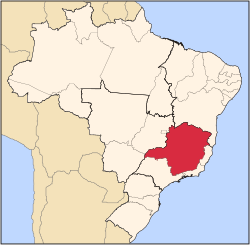Nova Lima | |
|---|---|
| Municipality of Nova Lima | |
 Location in Minas Gerais | |
| Coordinates: 19°59′09″S43°50′49″W / 19.98583°S 43.84694°W | |
| Country | |
| State | |
| Region | Southeast |
| Intermediate Region | Belo Horizonte |
| Immediate Region | Belo Horizonte |
| Incorporated | February 5, 1891 [1] |
| Government | |
| • Mayor | João Marcelo Dieguez Pereira (Cidadania) [2] |
| Area | |
• Total | 165,425 sq mi (428,449 km2) |
| Elevation | 2,460 ft (750 m) |
| Population (2020) [4] | |
• Total | 96,157 |
| Time zone | UTC−3 (BRT) |
| CEP | 34000-000 |
| Area code | 31 |
| HDI (2010) | 0.813 – very high [5] |
| Website | www |

Nova Lima is a municipality of about 87,000 people, whose downtown is located about 20 kilometers south of Belo Horizonte, the capital of the south-eastern Brazilian state of Minas Gerais. [6] Mining is one of the main economical activities of the city, including the extraction of Iron Ore and Gold. The most famous mine in the city is Morro Velho (Old Hill), a gold mine of 2,700 metres (8,900 ft) depth.

















